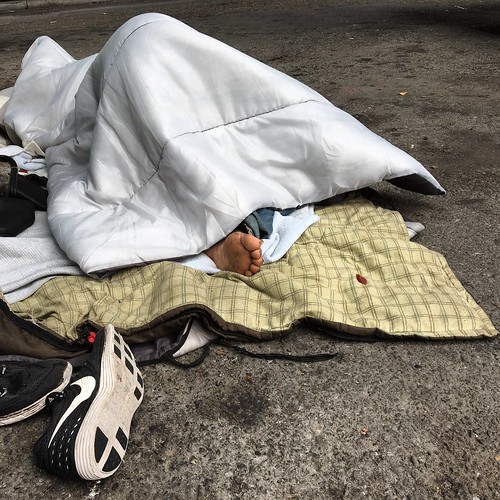
Broadway in Oakland, between 40th Street and MacArthur Boulevard.
I have been up and down this block hundreds of times driving, on the bus, on a bike, and on foot. Late this afternoon, while waiting for a prescription to be filled at one of the Kaiser pharmacies nearby, I took The Dog for a walk. On our way back, just below 40th Street and on what you’d call more or less accurately the east side of Broadway, we crossed a driveway and I looked up. A spare and striking archway said “The King’s Daughters Home.” I went back to the car, grabbed my camera, left the dog, then walked back to the gate. The name alone suggests there’s a story there.

The building, not pictured, is now owned by Kaiser and houses at least part of the organization’s psychiatric and counseling practice. What was it before? To me, “King’s Daughters” suggests what used to be called a lying-in (or maternity) hospital; maybe one for what used to be called young women in trouble.
The actual history: The Broadway facility was indeed a hospital, designed by architect Julia Morgan (perhaps best known as the architect of William Randolph Hearst’s castle on the Central California coast). A gallery of the King’s Daughters Home pictures gives its completion date as 1912, so we’re on the eve of the centennial. What kind of hospital was it?
First, the home took its name from the International Order of King’s Daughters (later “Daughters and Sons”), an interdenominational Christian organization that started in New York in 1886. According to the order’s history, the movement spread rapidly and had 50,000 members across the United States, Canada, and overseas within the first year. The group’s mission was to undertake good works in the name of Christ. If you look for the phrase “King’s Daughters” now, you come across many hospitals across the country that apparently began as projects by local King’s Daughters circles.
In 1890, a San Francisco circle organized The King’s Daughters Home for Incurables. In July 1895, the San Francisco Call detailed the home’s workings, including the high demand for services, the difficulty finding money to provide it, and rates for long-term patients (“life memberships can be secured for those above 60 years of age for $500…”). I’m not sure how long the San Francisco home lasted; I find references to it, first on Francisco Street in North Beach, then on Golden Gate Avenue in the Western Addition, through 1917.
A second home, sometimes called the Alameda County King’s Daughters Home for Incurables, opened in Oakland sometime in the late 1890s (were the two operations connected? I don’t know). A story in the September 3, 1902, edition of the Call suggests the home’s first East Bay location may have been at 11th and Oak streets, near the current site of the Oakland Museum of California). The story mentions a deadly fire there, and the May 10, 1902, Journal of the American Medical Association reported: “The north wing of the King’s Daughters’ Home for Incurables, Oakland, was destroyed by fire, April 28. Despite the heroic efforts of the matron, nurses’ and attendants, one inmate was fatally burned and another will probably die from injuries received.” (The San Jose Evening News published a more complete account under the headline “Awful Fire in Oakland Hospital.” The story reports: “That so many inmates were rescued is due to the prompt and heroic action of some of Oakland’s most prominent society ladies who resided in the vicinity of the Home.”)
The fire prompted the home to move to the property at 3900 Broadway, which contained both a building that could be used for temporary quarters and room for a new, permanent hospital. In subsequent years, the Call reported on plans for the new facility (“King’s Daughter Will Erect New Home for Incurables,” March 31, 1906) and a redoubled fund-raising effort to obtain the $100,000 needed to finish the project (August 23, 1910. The story says “Every home in Oakland, Berkeley, and Alameda is asked to contribute at least one dollar. Coin envelopes are being distributed from house to house by specially appointed workers, who may be identified by a badge they wear, with ‘King’s Daughters’ printed upon it. Every family is asked to donate what it can, inclosing the amount of the gift in the envelope, which will be called for Thursday, August 25, between the hours of 5 and 8 p.m.” )
Who were the incurables? Those who medical science of the day could not treat: stroke victims, the disabled, patients diagnosed with tuberculosis. One patient in the 1930s and ’40s is said to have been Bess Maddern London — Jack London’s first wife — who had suffered a crippling stroke.
Where did the patients and residents end up? Mountain View Cemetery, less than a mile away (and designed by another notable architect, Frederick Law Olmstead), reportedly has a section devoted to Kings Daughters patients.
Among the many things I don’t know: When the facility ceased being the King’s Daughters Home for Incurables. Still on the hunt for that, but I’ve got to get to bed.
[Update: One interlocutor asks: Where did the name “King’s Daughters” come from? The order’s history says a Mrs. Irving, one of the founders, suggested that title. “The King” was to be understood to be God. An 1888 poem by an early member spells it out:
“…Her Father sent her in his land to dwell,
Giving to her a work that must be done.
And since the King loves all his people well,
Therefore, she, too, cares for them every one.
Thus when she stoops to lift from want or sin,
The brighter shines her royalty therein. …”]




